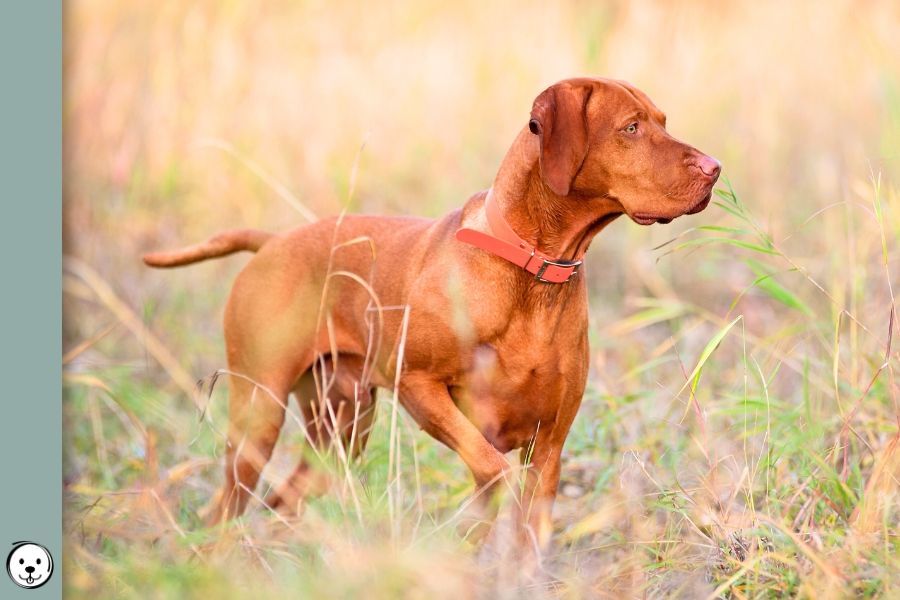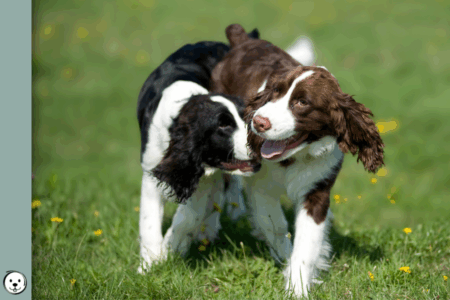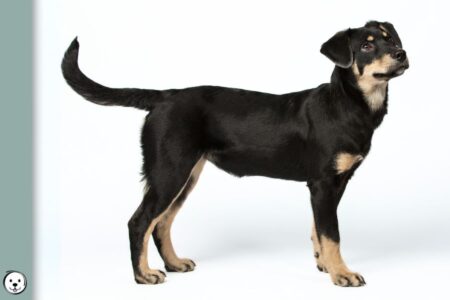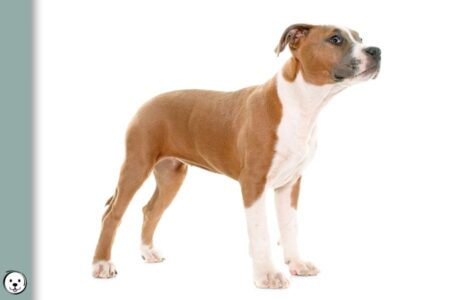The Vizsla is a short-haired hunting dog from Hungary. This versatile and easy-going dog breed is also popular as a companion dog if it has a job to do. But what color is a Vizsla?
Vizsla Color Chart
An overview of Vizsla colors.
| b/b e/e brown-based recessive red | |
| yellow sandy golden |  |
| golden rust russet gold semmelgelb | 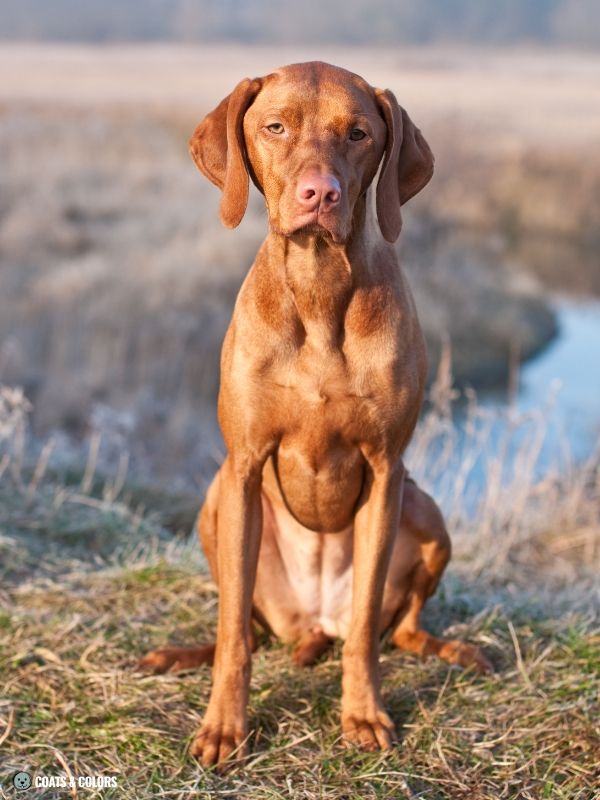 |
| rust red mahogany |  |
Vizsla Coat Colors Overview
The breed standard describes all the ideal Vizsla, including temperament and conformation.
The major kennel clubs often use their own breed terms for different color[1-3]:
| AKC | FCI | KC | |
|---|---|---|---|
| Golden Rust (in varying shades) | ✅ | (✅) | (✅) |
| Russet Gold (in varying shades) | (✅) | ✅ | ✅ |
| Dark Sandy Gold (in varying shades) | (✅) | ✅ | ✅ |
Brackets indicate color names that are not mentioned in the breed standard without excluding them.
Standard Vizsla Coat Colors
Let’s talk about the different Vizsla colors:
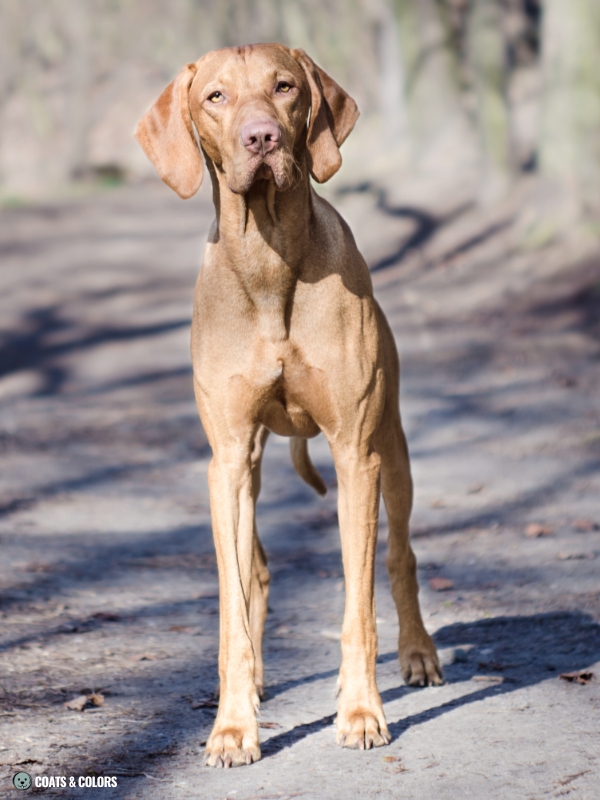

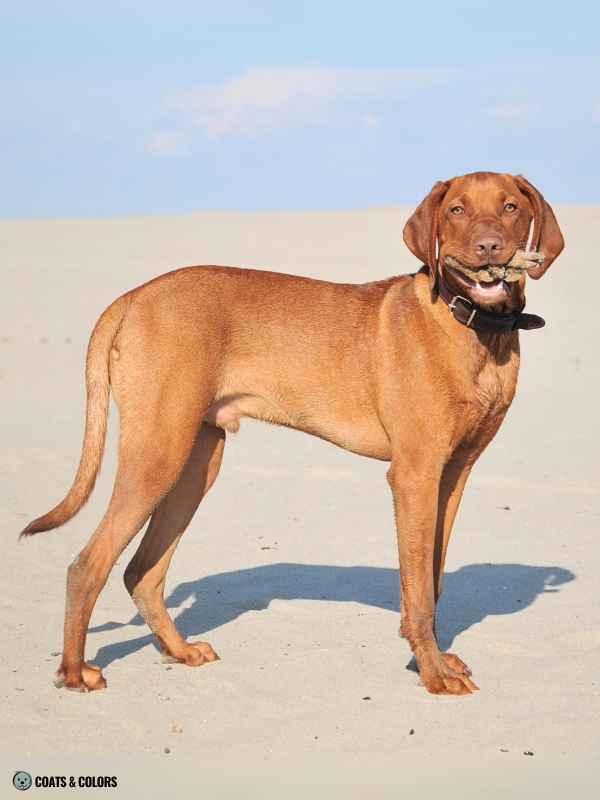
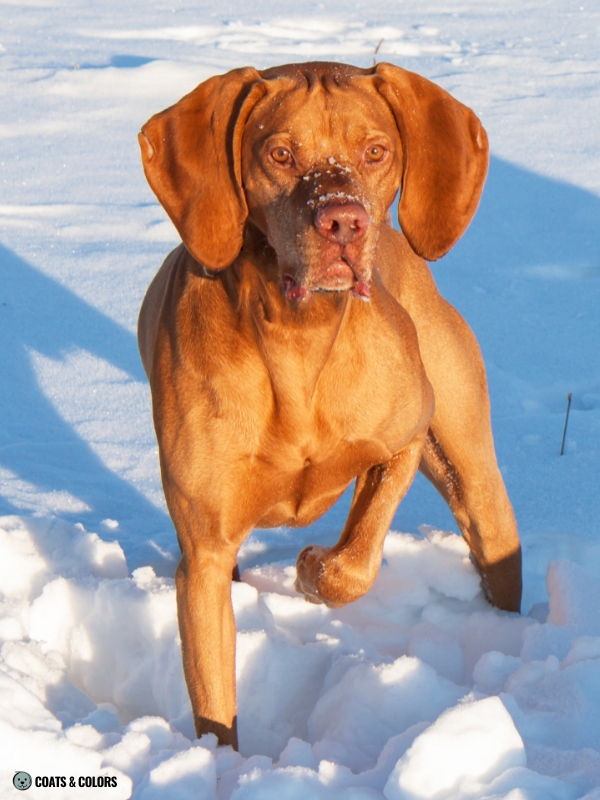

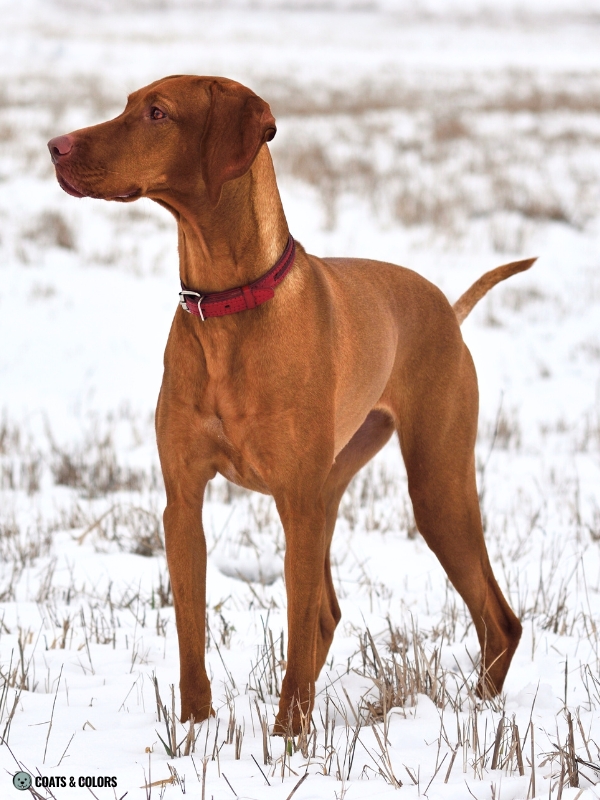
All Vizslas are brown-based (b/b) recessive red (e/e).
These dogs are always some shade of red (and never show any brown in their coat).
The brown eumelanin is visible only in their nose leather, eye rims, lips, paw pads, or toenails. Dogs can have greenish puppy eyes that will darken to a dark yellow or light brown eye color.
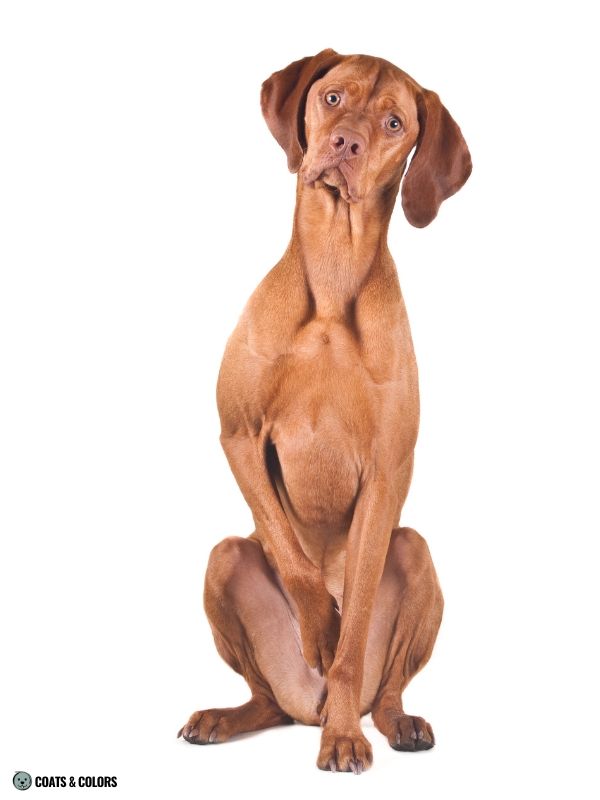
Their recessive red pattern causes them to only produce phaeomelanin in their coat.
This is a common pattern in purebred dogs from white Samoyeds to yellow Golden Retrievers to chestnut-colored Irish Setters. The only difference is that Vizlas are bred for an orangey phaeomelanin intensity they call “golden rust” and that they are fixed for brown eumelanin.
The intensity of red pigment in Vizlas can vary from a sandy yellow to a deep red.
However, breed standards do not favor dogs that are too pale or too intense in color. The preferred shade is a golden rust color, a shade of dark orange with a touch of yellow.
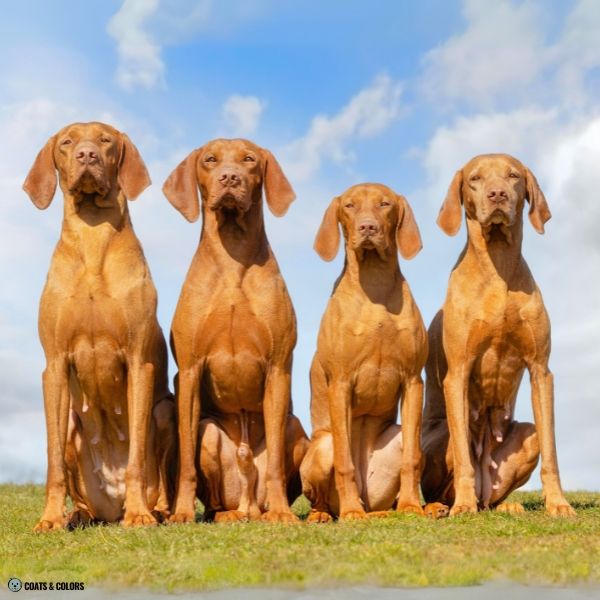
Vizsla folks use a lot of different breed terms to describe various shades of this golden russet color. But all shades of golden rust are accepted as long as they are neither too yellow nor too red.
Vizlas with a more yellow than red coloration are called “sandy yellow” or “golden“. There aren’t too many truly yellow Vizslas (blonde dogs are more common in the Wirehaired Vizsla breed).
Next, dogs with an orange hue in their golden coat are called “rust golden” or “red golden“. This is followed by dogs that have a golden touch to a predominantly orange coat which is called “golden rust“.
More intense colors are a dark orange called “rust” followed by “red“. The FCI thinks “red” and “brownish” are undesirable. The AKC only considers a more intense “dark mahogany” (AKC) to be faulty.
Every color that is not pale yellow or deep red seems to fall under the umbrella of “golden rust in varying shades” although anything but golden rust is officially listed as alternate color by the AKC.
“Golden rust in varying shades. Lighter shadings over the sides of the neck and shoulders […] are common.”
AKC Breed Standard
“Various shades of russet gold and dark sandy gold (semmelgelb). The leathers may be a little darker, otherwise uniform in colour.”
FCI Breed Standard
The standard of the national Magyar Vizsla Klub in Hungary calls the ideal color a “bun yellow” (meaning a bread roll or “baguette” color). The FCI standard kept this term and calls it “semmelgelb“.
Ultimately, there is no defined color palette and it is highly subjective when a Vizsla color turns from “sandy” to “golden” to “red golden” to “golden rust” to “rust” to “red” and so on.
The attempt to define very subtle shades and intermediate colors is a common phenomenon in breeds that only have one color. However, these made-up terms lack a precise definition.
What they’re trying to say is that Vizlas come in a yellowish orange color (“golden rust” just sounds a little more stylish) that comes out a little lighter or darker on some dogs than others.
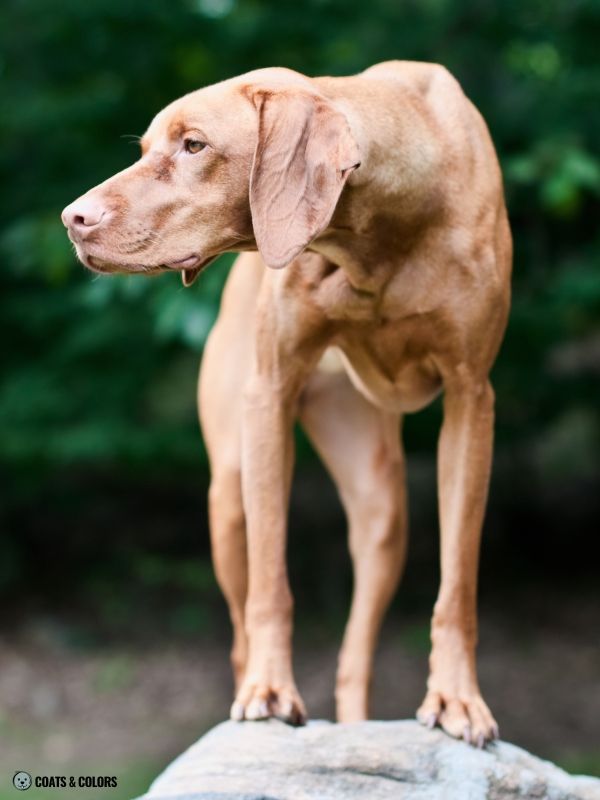

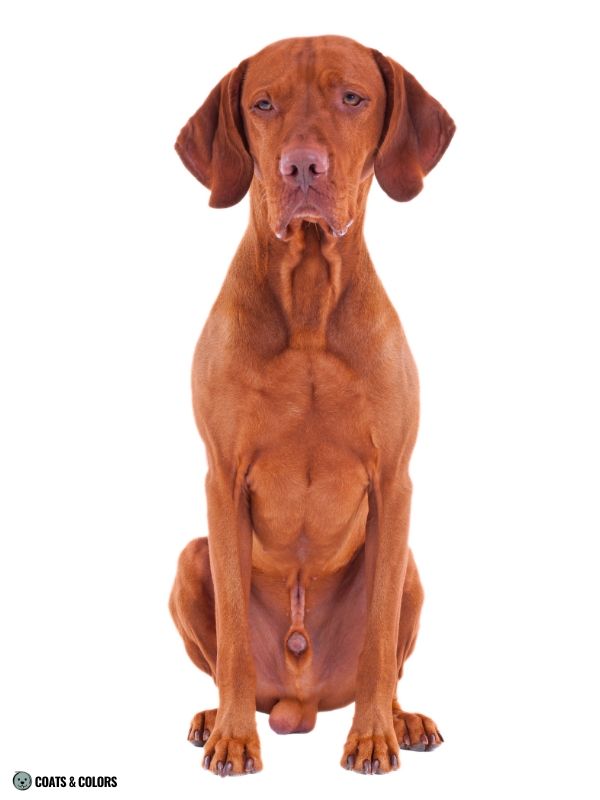
Some coat color change in young Vizlas is to be expected. Puppies tend to be born with a more blonde coat that will darken over time as red pigment continues to build up after birth.

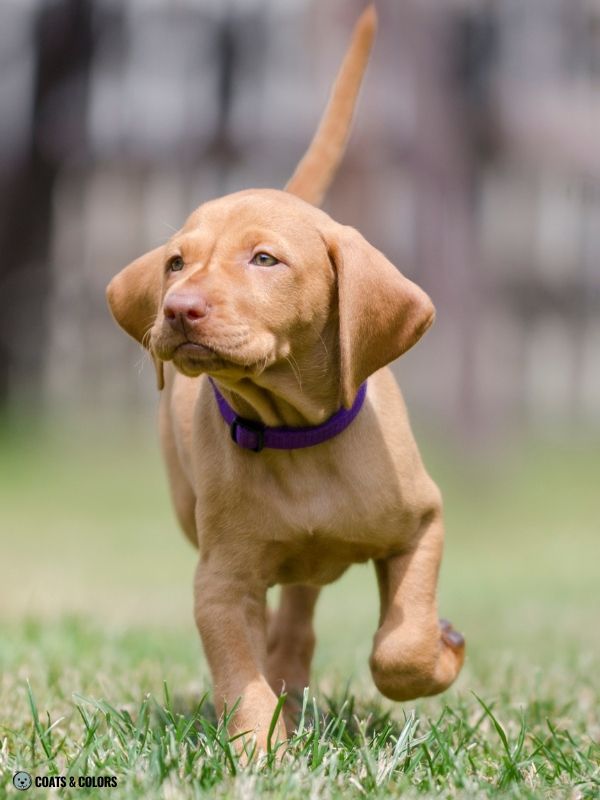

Small white markings on the paws and chest are tolerated but not deemed desirable.
Old age graying typically can be quite extensive in these dogs and typically starts on the chin, muzzle, and toes. Additionally, some dogs show premature graying.

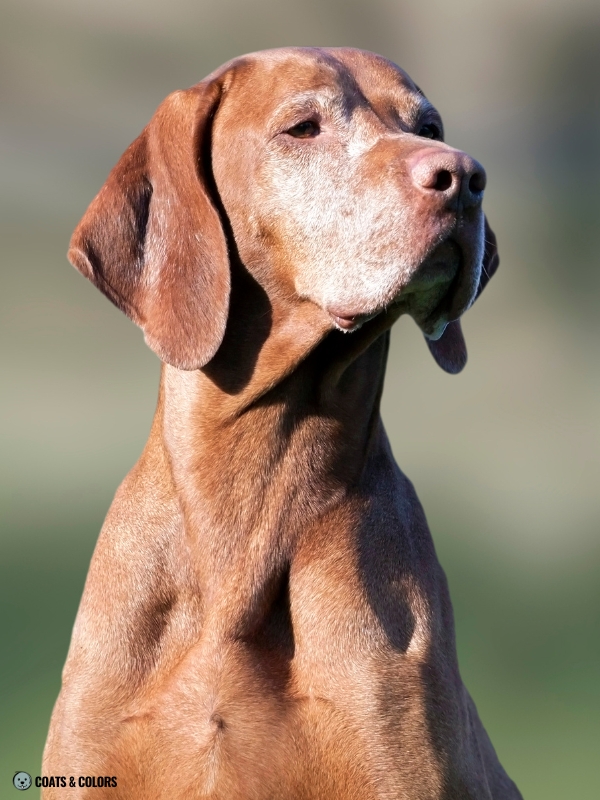

Vizsla Coat Color Genetics
All Vizsla are recessive red, they can only produce phaeomelanin in their coat, no eumelanin. This will always mask what a dog has at its A locus and K locus.
| E-LOCUS | e = recessive red |
| K-LOCUS (not expressed if e/e) | KB = dominant black kbr = brindle (???) ky = wild type, enables normal pattern |
| A-LOCUS (not expressed if e/e) | Ay = sable aw = agouti at = tan points a = recessive black |
| RED INTENSITY breed terms | pale yellow sandy yellow sandy gold golden red golden russet gold rust golden golden rust rust red dark mahogany |
| B-LOCUS | b = brown eumelanin |
| D-LOCUS | D = normal eumelanin d = diluted eumelanin (?) |
| S-LOCUS | S = solid sP = white markings |
| M-LOCUS | m = non-merle |
Vizsla Patterns
The A locus, K locus and E locus control all basic pigment distribution patterns.
They tell pigment cells when and where to make either eumelanin or phaeomelanin.
E Locus
Vizslas are always recessive red (e/e).
This means they can not express eumelanin in their coat, only phaeomelanin.
Even their whiskers will be white.
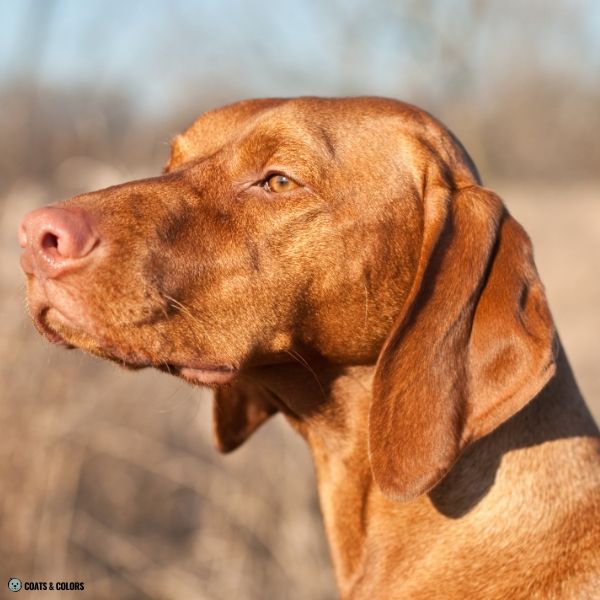
A Locus
Most Vizslas have one or two tan point alleles (at) at their A locus[4].
Some have sable (Ay) or recessive black (a).
However, they can not express these patterns due to their e/e genotype.
K Locus
Vizslas can have any of the known variants at their K locus.
The wild type variant (ky) is most common, but dominant black (KB) is also present and brindle (kbr) is possible. Because vizslas are e/e, they cannot express any of these patterns.
Eumelanin Colors
All Vizslas have brown eumelanin (b/b).
But can not show brown pigment in their coat due to their recessive red pattern.
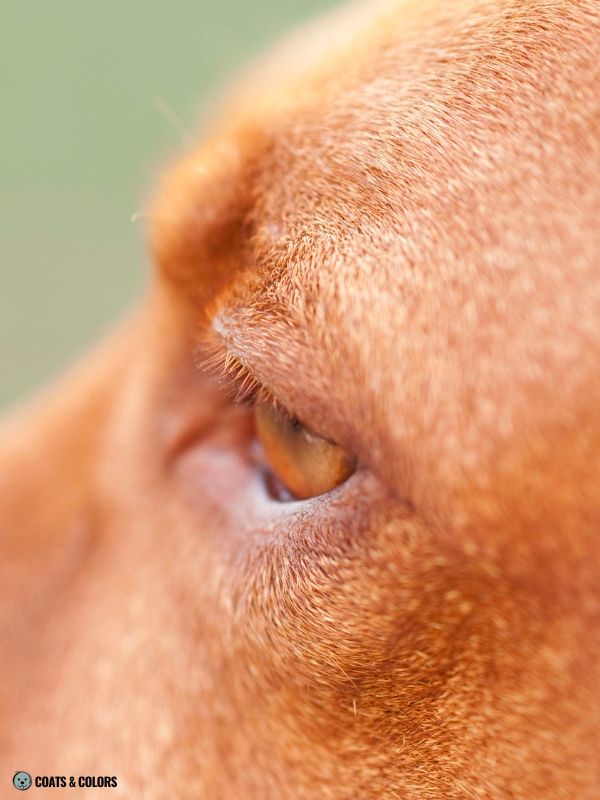
However, their eumelanin color is visible in their skin pigment, nose color, and nails.
“The Vizsla is self-colored, with the color of the eyes, eye-rims, lips, nose, toenails and pads of feet blending with the color of the coat.”
AKC Breed Standard
“The colour of the lips and the eye rims corresponds to the colour of the nose.”
FCI Breed Standard
Phaeomelanin Intensity
The phaeomelanin color in Vizslas ranges from sandy yellow to red with most of them having an orangey reddish pigment intensity. The AKC classifies the range of desirable colors as “golden rust“. The FCI refers to the same colors as “various shades of russet gold and dark sandy gold“.
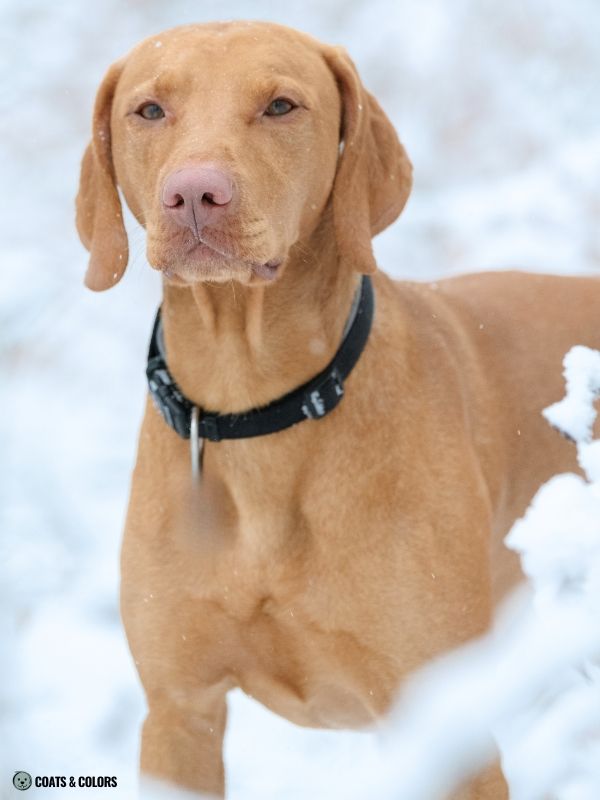
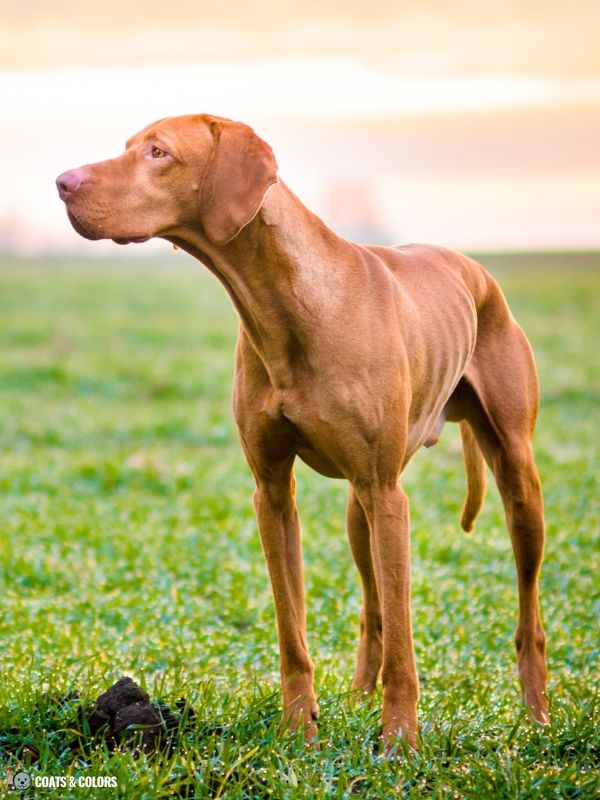
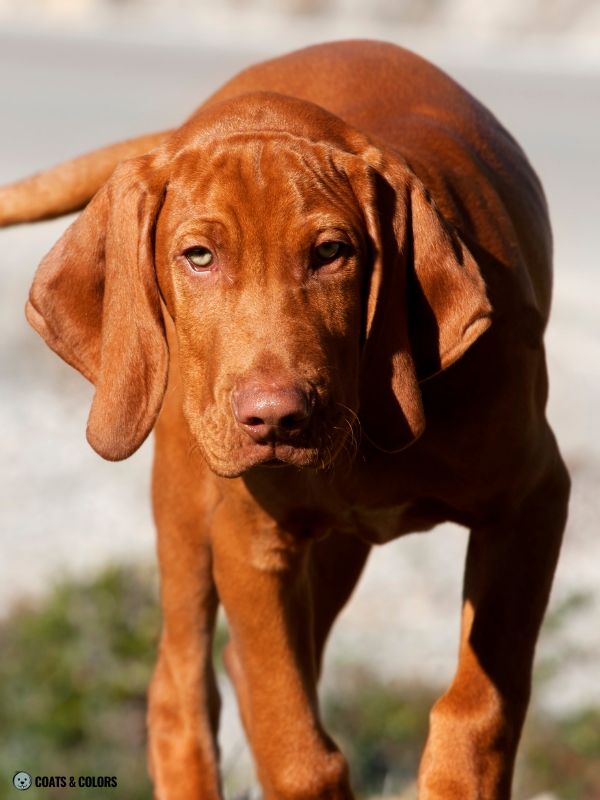
Some color gradients in various parts of the coat are normal for any recessive red dog.
The FCI standard mentions the leathers sometimes being a little darker.
Some lighter shading over the sides of the neck and shoulders is normal in most short-haired dogs due to their hair growth pattern. The Illustrated standard for AKC Vizslas calls it “saddle shading“[5].

“Solid dark mahogany and pale yellow are faulty.”
AKC Breed Standard
“Red, brownish or lightened colour is undesirable.”
FCI Breed Standard
White Markings
The Hungarian Vizsla breed is supposed to have a solid coat.
Some residual white is tolerated but less white is preferred.
The AKC standard clarifies that only chest white in an area from the top of the sternum to a point between the elbows is acceptable. The white must also not grow laterally beyond the points of the shoulders and never extend to the shoulder or neck area.

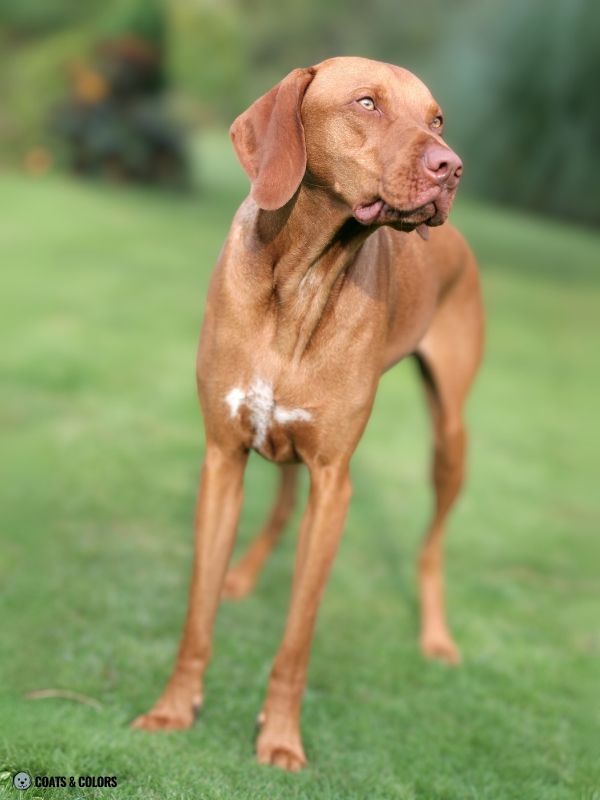
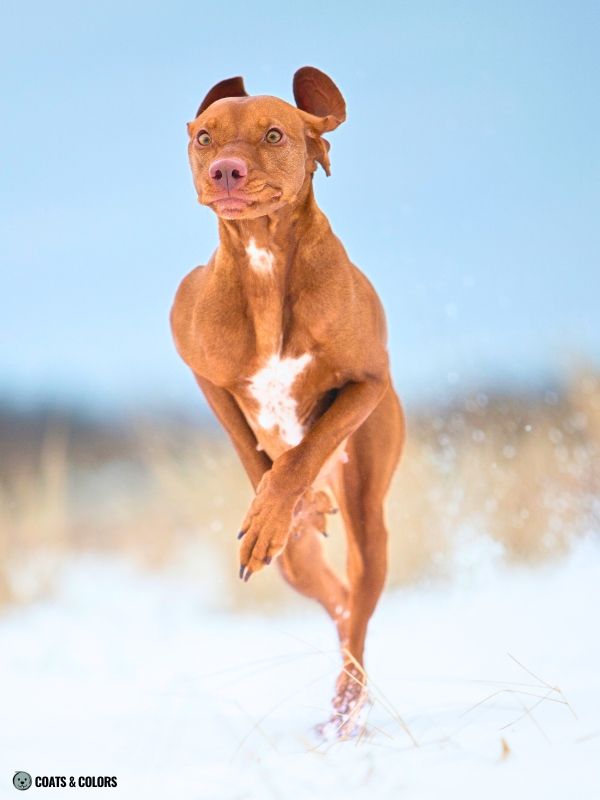
White on the paws can affect any portion of the toes but should not extend onto the pastern. The FCI sees fully white feet as a reason for disqualification from the show ring.
A small number of Vizlas seems to have a piebald variant (sP)[4]. This can cause minor to moderate white markings in heterozygous dogs (S/sP) and more white in homozygous (sP/sP) dogs.
“White on the forechest, preferably as small as possible, and white on the toes are permissible.”
“Disqualifications: […] Solid white extending above the toes or white anywhere else on the dog except the forechest. White extending on the shoulders or neck. “
AKC Breed Standard
“A little white patch on the chest or at the throat, not more than 5 cm in diameter, as well as white markings on the toes are not considered faulty.”
FCI Breed Standard
Coat Color Genotypes
Breed standards almost always use breed-specific and purely descriptive terms.
All Vizlas are fixed for a recessive red pattern with brown eumelanin. All the different shades of Vizla colors from golden to rust refer only to the variation in the intensity of their red.
| Color Term | Pattern |
|---|---|
| Sandy Yellow Golden Rust Golden Red Golden Golden Rust Rust Red … | e/e B/B brown-based recessive red + phaeomelanin intensity |
Vizsla Eye Colors
Vizslas can only produce brown eumelanin (b/b D/D).

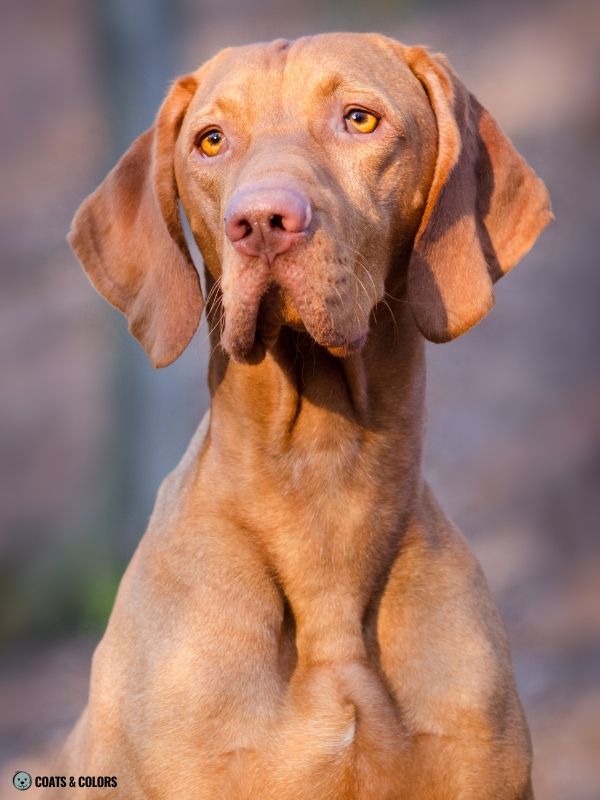

Dogs with brown pigment typically produce eye colors from light brown to light yellow. Puppies can have very light greenish eyes that will darken over time.
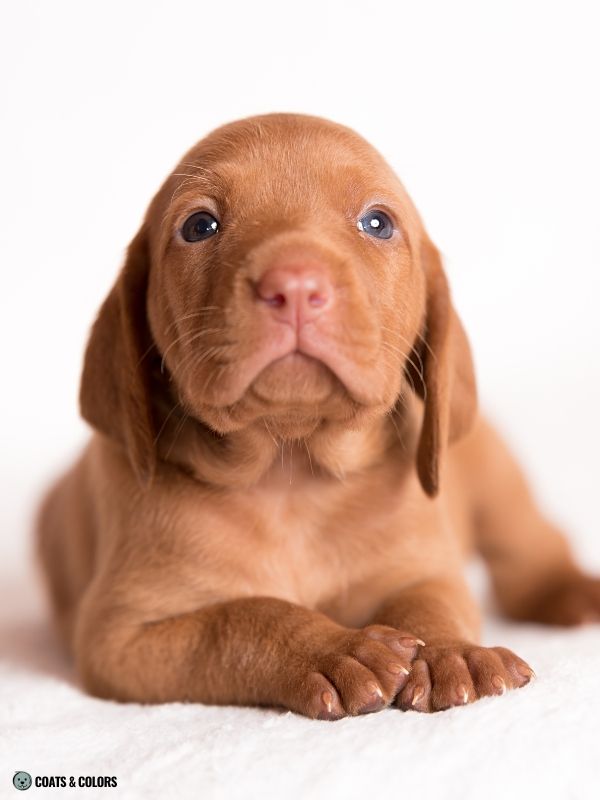
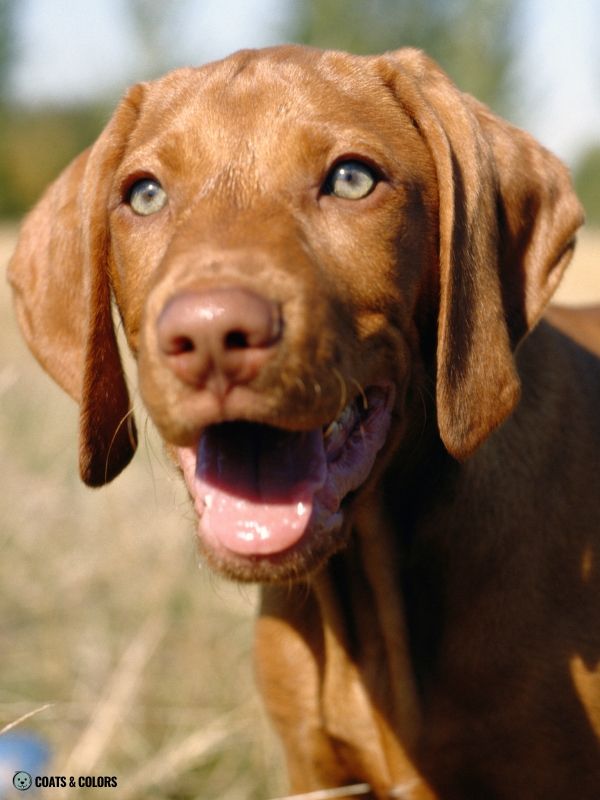
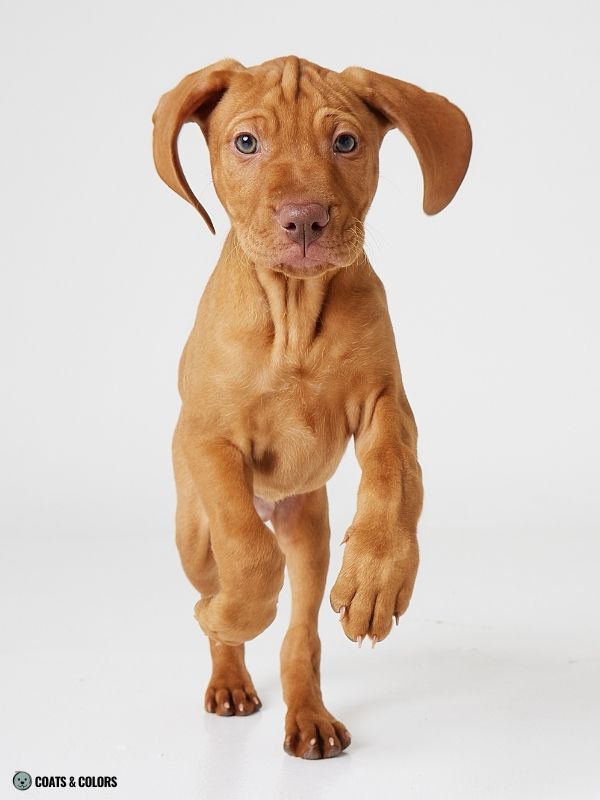
However, both the FCI and AKC standards do not accept yellow eyes.
“Color of the iris should blend with the color of the coat. Yellow or any other color is faulty.”
AKC Breed Standard
“The brown eye harmonising with the coat colour, as dark as possible preferred.”
FCI Breed Standard
Vizsla Nose Colors
All Vizslas are brown-based recessive red.
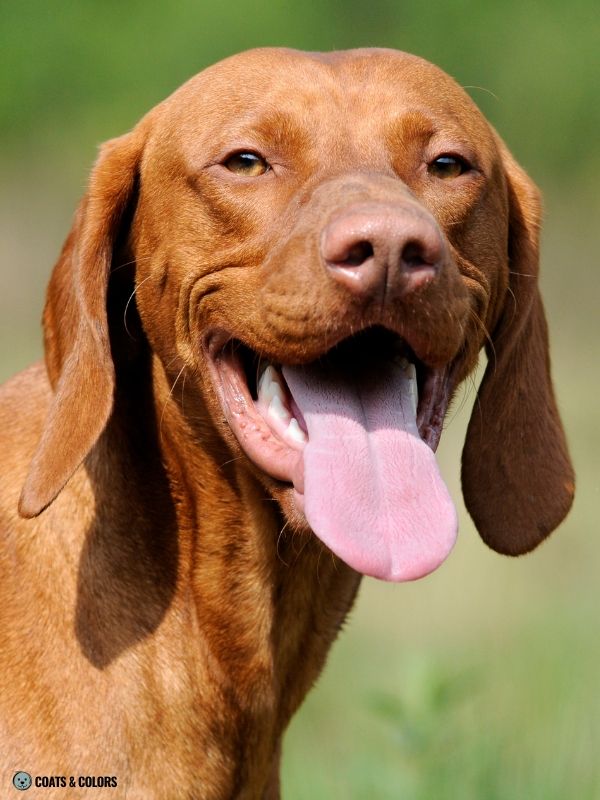
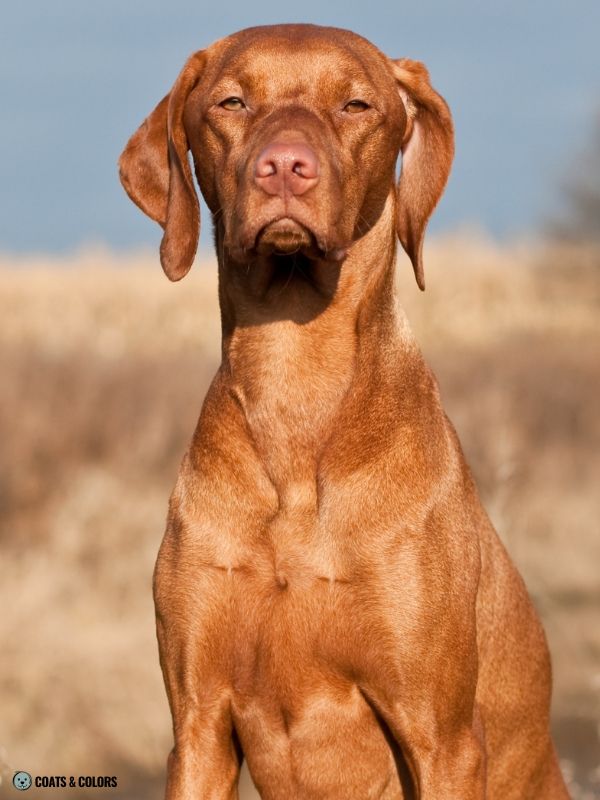
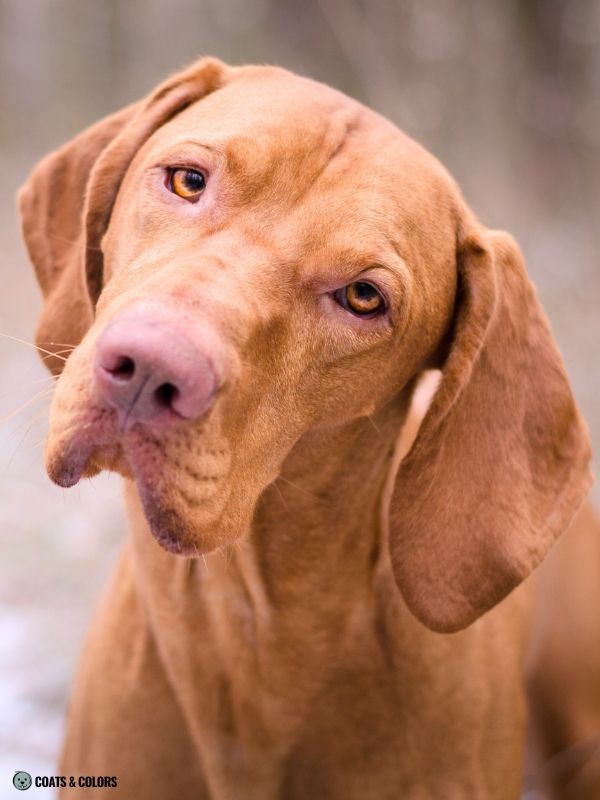
Their nose starts out solid brown but can show varying degrees of pigment fading in adults. The AKC defines the nose color as “a brownish red or brownish-pink color, not quite liver or dark brown“.
“Nose self-colored. Any other color is faulty. A partially or completely black nose is a disqualification. Freckles due to aging or sun exposure are not to be faulted.”
AKC Breed Standard
“The colour of the nose harmonises in a dark shading with the coat colour.”
FCI Breed Standard
The AKC wants darker dogs to have a darker nose and lighter dogs to have a lighter nose[5].
However, the red coat of the Vizsla gets its color from phaeomelanin. And the brown nose gets its color from eumelanin. The intensity of the red coat color and the presence or absence of nose hypopigmentation are not directly linked to each other, nor is their inheritance fully understood.
Vizsla Mismarks and Fancy Colors
Common mismarks in Vizlas include large white markings that extend up the legs or onto the throat.
And some dogs have a phaeomelanin intensity that may be deemed too pale or too red.
Whatever causes pale phaeomelanin seems to be mainly recessive to darker phaeo (red intensity is multigenic and not fully understood). Some normal-colored parents may produce lighter puppies.
Another idea is that some Vizlas may carry for recessive color dilution (maybe due to Weimaraner heritage). This would cause a lilac nose in homozygous d/d b/b dogs. While color dilution should only lighten eumelanin it can sometimes affect red intensity in e/e dogs (e.g. “buff” in Tollers).
But today all of these off-colors seem to be very rare in Vizlas.
“Partially or completely black nose.”
“Solid white extending above the toes or white anywhere else on the dog except the forechest.”
AKC Breed Standard
“Disqualifying Faults: […] Dark brown or pale yellow colour. Parti-coloured, not uniformly coloured. White chest patch larger than 5 cm. White feet.”
FCI Breed Standard
Another type of mismark is any color other than solid red with a brown nose.
Vizsla coats get their solid red color from a double homozygous recessive genotype.
Hungarian pointers are always e/e at their E locus. And they all are b/b at their B locus.
A homozygous recessive dog can not carry a dominant allele. Meaning a dog that is e/e at its E locus can only pass on e to its puppies, nothing else. And b/b can only pass on b.
Breeding e/e b/b to e/e b/b can only ever produce more e/e b/b puppies!
All Vizsla that express black eumelanin (B/-) must have had a black-nosed parent that had a B allele to pass on. Two brown-based Vizslas (b/b x b/b) can not produce a black-based puppy (B/-).
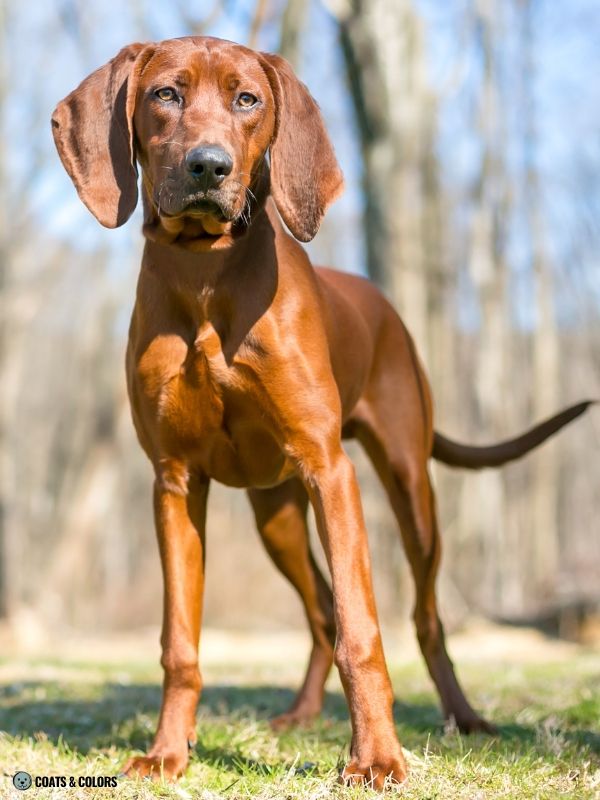
All Vizsla with a patterned (e.g. black and tan) or solid eumelanic coat (from being dominant solid E/- KB/- or recessive solid E/- ky/ky a/a) must have had a parent that provided an E or Em allele and couldn’t have been e/e itself. A Vizsla-type dog with a mismarked coat might be mixed with GSP or Weimaraner.
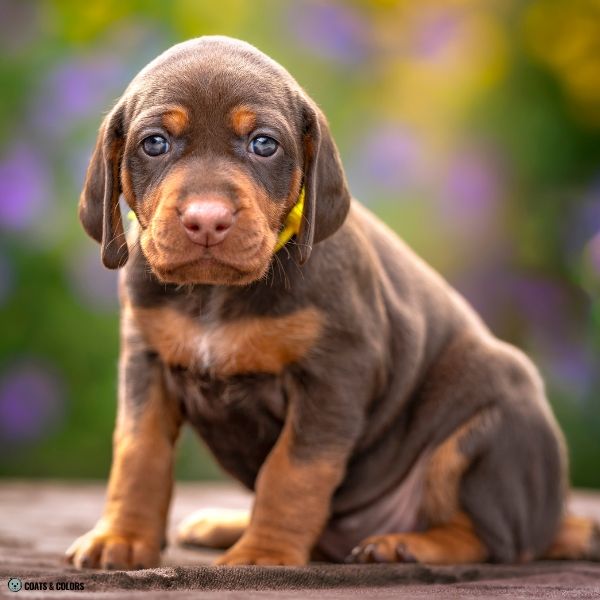
The only color that could resemble brown-based recessive red is a brown-based sable pattern (E/- ky/ky Ay/-). However, these dogs will have brown whiskers and some amount of brown (puppy) shading.
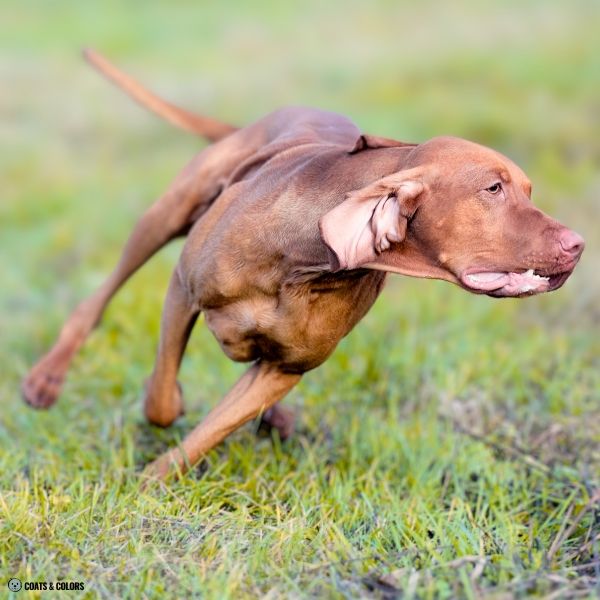
Vizsla Coat Types
The Vizsla is a smooth-haired pointer dog with a short functional coat.
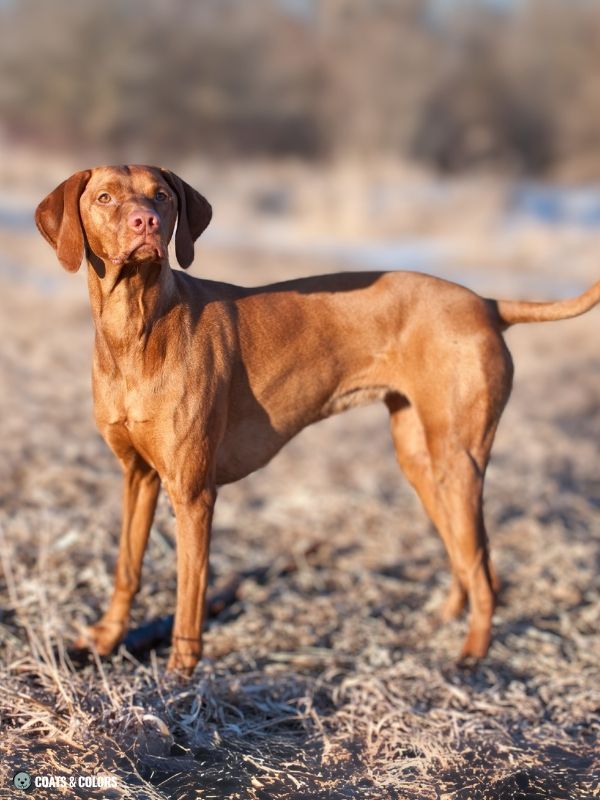
“Short, smooth, dense and close-lying, without woolly undercoat.”
AKC Breed Standard
“Short and dense, should be coarse and hard at the touch. […] No undercoat.”
FCI Breed Standard
Other Coat Types in Vizslas
Short coat is dominant and most Vizlas have two short coat alleles (L/L). However, some long coat carriers (L/l) can produce a long-haired coat in their homozygous recessive puppies (l/l)[4].
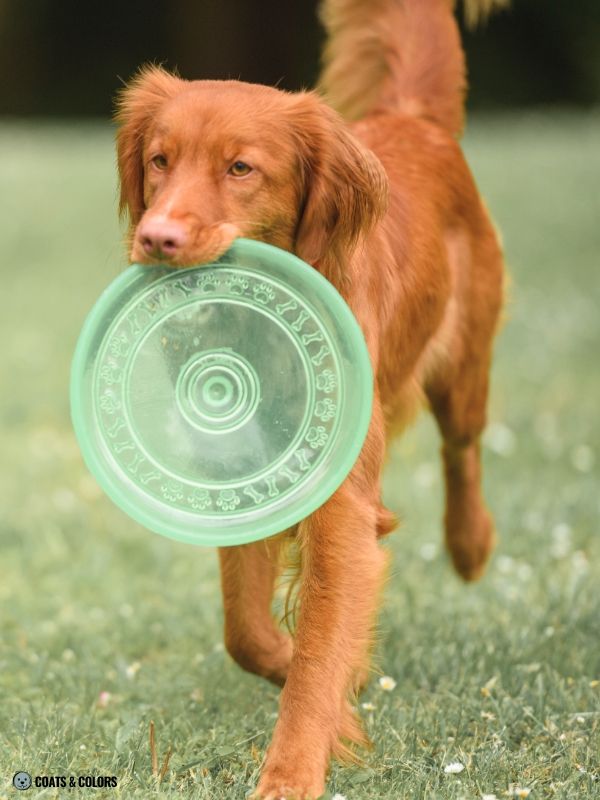
Some Vizlas test positive for furnishings without producing a bearded phenotype. A dog that expressed its furnishings would likely be indistinguishable from a Wirehaired Vizla coat type.
“A distinctly long coat is a disqualification.“
AKC Breed Standard
“Disqualifying Faults: […] Atypical coat.”
FCI Breed Standard
Learn More
Links
[1] American Kennel Club (AKC): Official Standard of the Vizsla (pdf)
[2] Fédération Cynologique Internationale (FCI): Vizsla Breed Standard
[3] The Kennel Club (KC): Vizsla Breed Standard
[4] Dreger et al. (2019). True Colors: Commercially-acquired morphological genotypes reveal hidden allele variation among dog breeds, informing both trait ancestry and breed potential. PLoS ONE 14(10): e0223995. https://doi.org/10.1371/journal.pone.0223995
[5] Vizsla Club of America: Vizsla Illustrated Standard

Hi! I’m Steffi. I am a biologist and a big time dog nerd. You are curious about coat color genetics? You’ve come to the right place! Read more.

